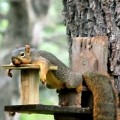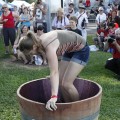USELESS BOOKS . . . by Joseph G. Evrard, Staff Kentuckian

I was in the library the other day looking for copies of the latest bestsellers when it occurred to me that there might be something to learn from a list of “worst” sellers. Everybody pays so much attention to what books are popular and why they appeal to the great masses.
Shouldn’t it be equally fascinating to learn why some books don’t sell? Always one to look on the unexplored side of things, I took my quest to the head librarian who, obligingly enough, showed me to a room down in the bowels of the building. On the door was a sign, “LOSERS.”
The librarian explained, “This is where we put books we buy for the library’s collection, but nobody ever reads. If a book hasn’t been looked at in 10 years, we put it down here just in case. You’re the first person in our history who has ever asked to see what’s here. Enjoy yourself. Please turn out the light when you leave.” The librarian was gone and I was alone in a room with shelves of books not read. I felt like Columbus setting sail on a voyage of discovery. Let me share with you a few of the discoveries of that day.
The Great Book of Lint – This scholarly tome weighs about 20 pounds and is undoubtedly the most comprehensive work ever undertaken on a subject nobody cares about. The author tediously traces the history of lint from its discovery in early civilization to the many forms we find it in today. Included are many charts and graphs categorizing lint by color, texture, feel, particle size, specific gravity, and many other physical attributes.
A special section lists all known names for types of lint in all languages in use on the planet today (local dialects included). Thus, if you’re corresponding with someone in northern Borneo and want to sound like you know what you’re talking about, lint-wise, you can just go to this section and pick out the word you need. Also notable is the section on comparative lint types based on local flora varieties.
The photographs are excellent. I’d recommend this book to anyone unfortunate enough to be even mildly interested in lint. To any normal, person, not so much.
Fred’s Comprehensive Encyclopedia of Non-Facts – Nowhere in the introduction or in any supporting material could I find out who in the world Fred is (or was). Notwithstanding, this Fred person seems to have done an admirable job of reminding us of things we already knew and weren’t curious about. For example, the treatise on why cows don’t compete in English Channel swimming is notably dull and boring. Equally uninteresting is a pronouncing gazetteer of common British housefly nicknames.
This sort of tripe goes on for page after page through all 12 volumes of this colossal waste of paper and printer’s ink. Case in point. Did you know that no major automobile manufacturer anywhere in the world has ever funded a research effort to investigate the feasibility of using rubber drive shafts in their vehicles? I’ll bet you could have guessed that without this book to tell you!
Arnold’s Complete Compendium of Unsuccessful Kool-Aid Flavors – This rather thin volume reads like a bad memory of a gastric nightmare. Selected entries include Dill Pickle, Raw Egg and Walrus.
A Beginner’s Guide to Beginning – This appears to be an early version of a self-help book aimed at those having trouble getting started. The only problem I could find with it is that the entire book is a lengthy introduction.
How the Worms Went West – Did you know that the early pioneers who pushed our country’s boundaries westward encountered a vast hostile land containing no worms? Imagine the difficulty these poor unsuspecting explorers had catching fish for dinner on the trail. Imagine the flocks of poor starving robins they met carrying signs reading, “Will work for worms.” This remarkably uninteresting attempt at an adventure story tells of the exploits of the early wormers, settlers whose sense of environmental responsibility and justice would not let them rest until they had seen to it that the ENTIRE country had worms, just like on the East Coast.
Follow their boring story as they carted wagon load after wagon load of wriggling, writhing worms westward into the sunset. Join them in their hollow triumph as they tried to start the “Worm Rush” by planting nests of worms at Sutter’s Mill in California. Learn why these unsung and long forgotten pioneers deserve to be forgotten.
Kite Diplomacy – This is more an essay than a book. The author makes the point that countries would get along better if they had more exchange programs aided at teaching the subtleties of kite flying among cultures of the world. “Not until you understand how the other person’s kite bites the wind can you understand the other person,” claims the author.
So there you have it. Our first venture into the world of books nobody has ever read. Hope you’ve enjoyed this little visit. There are lots more books I’m ready to tell you about, every one of them in all their boring, mind-numbing lack of glory.
See Ya Around,
Buck





